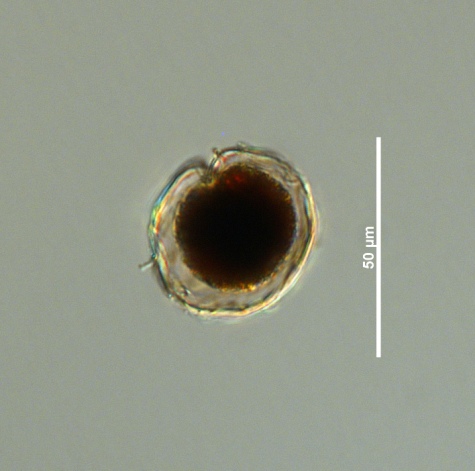


|
Synonym(s)
Gonyaulax exccavata (Braarud) Balech 1971
Gonyaulax tamarensis var. excavate Braarud 1945
Gessnerium tamarensis (Lebour) Loeblich and Loeblich 1979
Protogonyaulax tamarensis (Lebour) Taylor 1979
Protogonyaulax excavate (Braarud) Taylor 1979
Alexandrium excavatum (Braarud) Balech and Tagen 1985
(Smithsonian 2011, Kraberg et al. 2010)
Classification
(Guiry and Guiry 2011)
Lifestyle
Gamete
A reproductive cell (sperm or ovum) that can combine with another reproductive cell to create a new individual.
gametes CloseAnisogamous
Sexual reproduction involving two dissimilar gametes, e.g. sperm and egg.
(anisogamy; Smithsonian 2011). It produces oval resting CloseCyst
"A thick-walled dormant cell" (Horner 2002).
cysts with smooth wall. Its resting cysts contain reddish lipids and are covered with mucus (Kraberg et al. 2010).Description
Epitheca
In thecate dinoflagellates, the anterior part of a dinokont cell above the cingulum. The equivalent of epicone for naked dinoflagellates.
epitheca and CloseHypotheca
In thecate dinoflagellates, the posterior part of a dinokont cell above the cingulum. The equivalent of a hypocone for naked dinoflagellates.
hypotheca that are nearly equal in size (Smithsonian 2011).Measurements
Width: 17 - 44 μm
Similar species
Ventral
Relating to the underside of an organism; abdominal.
ventral pore which may be difficult to see (Smithsonian 2011). Also, A. catenella can form chains of 2-16 cells while A. tamarense is solitary.Harmful effects
Habitat
Distribution
Alexandrium tamarense is mostly found in coastal cold temperate waters of North America, Europe and Japan (Smithsonian 2011). It is broadly distributed in the North Atlantic and southern North Sea (Kraberg et al. 2010). It has also been reported in warm Mediterranean waters off northern Africa (Armi et al. 2011). Non-toxic strains of Alexandrium tamarense have been reported in Australia and the Gulf of Thailand (Smithsonian 2011).
Summer (July to August).
Growth conditions
Environmental Ranges
Temperature range (°C): -1.770 - 27.590
Nitrate (μmol L-1): 0.275 - 4.405
Salinity: 21.680 - 30
Oxygen (mL L-1): 4.600 - 8.712
Phosphate (μmol L-1): 0.071 - 1.153
Close
Silicic acid
A general term to describe chemical compounds containing silicon, oxygen and hydrogen with a general formula of [SiOx(OH)4-2x]n. Diatoms polymerize silicic acid into biogenic silica to form their frustules (Azam and Chisholm 1976).
Silicate (μmol L-1): 0.927 - 14.986Bloom characteristics
References
Anderson, D. M. 1998. Physiology and Bloom Dynamics of Toxic Alexandrium Species, with Emphasis on Life Transitions. Physiological Ecology of Harmful Algal Blooms. G: 41.
Armi, Z., Milandri, A., Turki, S., Hajjem, B. 2011. Alexandrium catenella and Alexandrium tamarense in the North Lake of Tunis: bloom characteristics and the occurrence of paralytic shellfish toxin. African Journal of Aquatic Science. 36(1): 47-56.
Encyclopedia of Life (EOL). 2011. Alexandrium tamarense (Lebour) E. Balech 1985. http://eol.org/pages/910083/overview. Accessed 05 Nov 2011.
Fauchot, J., Levasseur, M., Roy, S., Gagnon, R. Weise, M. 2005. Environmental Factors Controlling Alexandrium tamarense (Dinophyceae) growth rate during a red tide event in the St. Lawrence estuary (Canada). Phycological Society of America. 41: 263-272.
Guiry, M. D., Guiry, G. M. 2011. Alexandrium tamarense (Lebour) E. Balech 1985. http://www.algaebase.org/search/species/detail/?species_id=40299&sk=0&from=results. Accessed 05 Nov 2011.
Horner, R. A. 2002. A Taxonomic Guide To Some Common Phytoplankton. Biopress Limited, Dorset Press, Dorchester, UK. 200.
Kraberg, A., Baumann, M., Durselen, C. D. 2010. Coastal Phytoplankton Photo Guide for Northern European Seas. Verlag Dr. Friedrich Pfeil, Munchen, Germany.203.
Medcof, J. C. 1985. Life and death with Gonyaulax, an historical perspective. In: Anderson, D. M., White, A. W., Baden, D. G. (eds.) Toxic Dinoflagellates. Elsevier, New York, 1-8.
Smithsonian Institution. 2011. Alexandrium tamarense (Lebour) E. Balech 1985. http://botany.si.edu/references/dinoflag/Taxa/Atamarense.htm. Accessed 06 Nov 2011.
